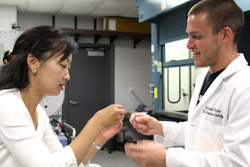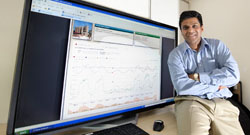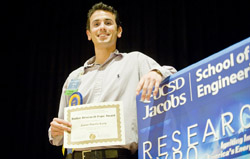Jacobs School of Engineering Researchers
Developing New Approaches to Saving Energy
Daniel Kane | Dec. 13, 2010
While researchers across all six departments of the UC San Diego Jacobs School of Engineering worked on sustainability-related projects in 2010, a trio of projects stand out because they each involve saving energy, but in vastly different ways.
Saving Energy in Next-Generation Batteries

NanoEngineers led by professor Shirley Meng are developing batteries of the future for hybrid electric vehicles or full electric cars.
“In my group, we are very interested in batteries that will be used in future transportation systems. Lithium batteries for plug-in hybrid electric vehicles or full electric cars have a lot of potential, but we have to work very hard to decrease the dollar per kilowatt hour numbers,” said Meng, whose research group at UC San Diego -- the Laboratory for Energy Storage and Conversion -- is funded through grants from the U.S. Department of Energy (DOE) and other government and industry sources.
“If we are going to use large-scale batteries for applications such as electric cars, it is not acceptable to replace batteries every three years. The cycle life of the batteries becomes very important and this is a challenge to address. How do we make batteries last for ten years instead of three years? We have to look for other options for the structure of the battery materials that are more robust,” said Meng.
Saving Energy across the Network

Meanwhile, UC San Diego computer scientists developed software called SleepServer that allows personal computers connected to large networks (enterprise environments) to save energy and money by “sleep-working.”
Sleep-working enterprise PCs are accessible via remote connections and maintain their presence on voice over IP, instant messaging, and peer-to-peer networks even though the PCs are in low-power sleep mode. SleepServer can reduce energy consumption on enterprise PCs previously running 24/7 by an average of 60 percent, according to a peer-reviewed study presented by UC San Diego computer scientists on June 25 at the 2010 USENIX Annual Technical Conference in Boston.
“Reducing the electricity required to run our information technology infrastructure is an absolute must, and our SleepServer technology is an important step in this direction,” said Agarwal. “Our goal with SleepServer is to help buildings with heavy IT-loads reach net-zero energy use – so that these buildings effectively become carbon neutral by generating as much renewable energy as they consume.”
At the 2010 Design Automation Conference on June 17, Agarwal, who received his doctoral degree in computer science from UCSD in 2009, and UC San Diego environmental engineering professor Jan Kleissl presented their calculations on how SleepServer can play an important role in balancing a modern building’s energy consumption and renewable-energy generation over a one-year period.
“If you cannot measure energy use, you will not be able to make much headway in reducing your energy footprint,” said Agarwal.
High-Efficiency Solar Concentrators

Over in electrical engineering, researchers led by electrical engineering doctoral student Jason Karp are saving energy from the sun. The engineers designed and built prototypes for new and improved solar concentrators. The design will cut the number of required photovoltaic cells – as compared to existing solar concentrators – and could lead to less expensive and more environmentally friendly solar installations.
While engineers have already developed high-efficiency solar concentrators that incorporate optics to focus the sun hundreds of times and can deliver twice the power of rigid solar panels, the new design offers potential new benefits. Karp built a working prototype with just two primary optical components, thus reducing materials, alignment and assembly. This solar concentrator is compatible with high-volume, low-cost manufacturing.
For this work, Karp won the 2010 Rudee Research Expo Outstanding Poster Award on April 15th at the 29th Annual Research Expo at the UC San Diego Jacobs School of Engineering.
Karp and colleagues did this research in the Photonic Systems Integration Laboratory led by Joseph Ford, a professor in the department of electrical and computer engineering. Jacobs School postdoctoral researcher Eric Tremblay (ECE Ph.D., ’08) and electrical engineering doctoal student Katherine Baker collaborated on the project.
Read related stories on UC San Diego gravitating towards Green:

|